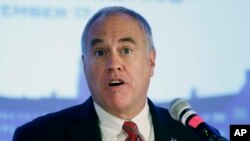New York's comptroller plans to shift domestic stock holdings in the state retirement fund to companies with lower carbon emissions in a new $2 billion index.
The investment strategy was announced Friday at the U.N. Climate Change Conference in Paris.
It includes another $1.5 billion going separately into "sustainable investments,'' doubling that program, and raising its total combined commitments to $5 billion, Comptroller Thomas DiNapoli said. The index will reduce or eliminate investments in companies that are large contributors to carbon emissions, such as those in the coal mining industry, he said.
"We're hoping to use the markets to move the companies in the right direction,'' DiNapoli said. The shift will occur over months and could expand, he said.
DiNapoli is sole trustee of New York's $173.5 billion retirement fund for more than 1 million state and local government workers, retirees and beneficiaries. In its last quarterly report, it had 37 percent of its portfolio in domestic equities, or about $64 billion.
The index is expandable. Designed with Goldman Sachs Asset Management, it's intended to shift stock holdings without lowering returns. It weights stocks based on information reported to the Carbon Disclosure Project, which collects environmental impact data from thousands of firms.
DiNapoli, participating in an investors panel in Paris, said the strategy is about managing investment risk from climate change and related regulatory oversight and should encourage companies to lower their greenhouse gas outputs. There's no doubt emissions are warming the planet and presenting risks that can't be ignored, he said.
"Low-carbon, sustainable investments are key to our future,'' he said.
The low-emission index will be internally managed by the fund and includes stocks in which the fund already has holdings, said Vicki Fuller, the fund's chief investment officer. "We feel certain we will be looking to increase this,'' she said.
Hugh Lawson, head of Goldman's global environmental, social and governance efforts, said there's "a significant amount of reweighting, with some exclusions'' while providing the New York fund opportunities to engage companies in which it increases or decreases holdings.
"The important thing is the emissions reduction is very substantial in the index,'' Lawson said. "We can lower their emissions by up to 70 percent, but we keep the essential risk and return characteristics of their U.S. large cap equity benchmark, which is the Russell 1,000.''
The New York fund's separate Sustainable Investment Program applies across asset classes, with current investments ranging from a wind farm in New York state to alternative energy production around the globe, according to the comptroller's office. About 15 percent of the fund's entire portfolio is in international stocks.
"The tide is shifting now,'' said Mindy Lubber, president of the nonprofit Ceres and director of the Investor Network on Climate Risk, which includes 115 institutional investors who collectively manage over $13 trillion in assets. DiNapoli is on its board.
Seven or eight states' pension funds have begun looking at climate risks and shifting investments, Lubber said. California, New York and New York City funds are leaders. Some big investment banks, like Citigroup and Bank of America, have begun doing it also, she said.
"Tackling climate change requires a colossal shift in investment capital flows toward clean energy and away from high-polluting fossil fuel energy,'' she said. "This announcement helps achieve this shift, but it's still only the tip of the iceberg of what all institutional investors need to be doing.''









